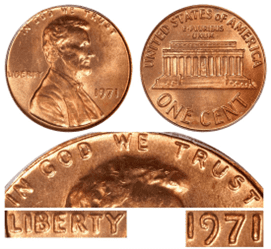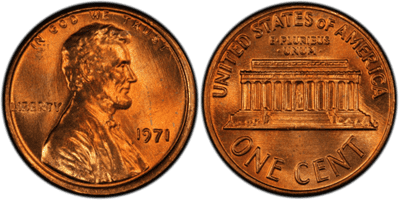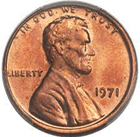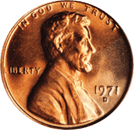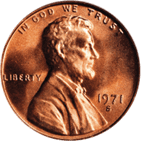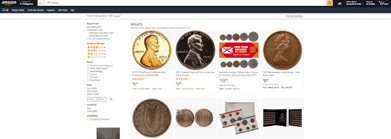What Is Special About A 1971 Penny?
The penny is the lowest denomination of coins in the United States. It is worth 1 cent or $0.01. As this might be the case, there’s something about the penny, specifically the 1971 penny, that still makes it special.

photo source: USA Coin Book
The 1971 penny is composed of 95% copper and 5% zinc. It is not made of silver. The diameter is 19 mm and the weight is 3.11 grams.
The penny was first struck in 1909 by the United States Mint. At that time, the first design included two stalks of wheat. Thus, it was often called “wheat pennies.” Later, the design included a bust of President Abraham Lincoln as a way to honor his great work for the nation.
Talking about the design, the 1971 penny’s obverse side has Lincoln facing right. Atop of the coin is the US motto, “IN GOD WE TRUST.” On the right side of Abraham is the year, “1971.” If a mint mark is included, it would be shown under the 1971 inscription. On the left side of Lincoln is the word “LIBERTY.”

photo source: PCGS
On the reverse side (tail), a front view of the Lincoln Memorial is included, which was designed by Frank Gasparro. Atop the coin includes the arching “UNITED STATES oF AMERICA.” Between that and the memorial, another US motto was included, “E. Pluribus Unum,” which means out of many, one. Below is the arching “ONE CENT.”
Why Is The 1971 Penny Rare?
Generally speaking, the 1971 penny isn’t rare. Throughout its production, there are about 3.6 billion 1971 pennies that have been struck. Here’s the breakdown:
- San Francisco – 525,133,459 pennies
- Philadelphia – 1,919,490,000 pennies
- Denver – 2,911,045,600 pennies
You can easily find 1971 pennies in various stores. However, there’s one type of 1971 penny that is rare thanks to an error occurring during production.
This rare coin is known as the 1971 doubled die penny. This happened when the obverse side of the coin was minted twice. As a result, you can find minute double marks on the coin.
To give you an idea, here’s what a doubled-die penny looks like. In the inscription, “IN GOD WE TRUST,” you’ll find an obvious doubling of the letters as shown here:

photo source: Couch Collectibles
An uncirculated, MS 65-graded 1971 penny with no mint mark plus the doubled die error can sell up to $50. However, the same 1971 penny with a PR 65 grade can sell for up to $500.
Here’s another look at what a doubled-die penny looks like. Notice the doubling or overlapping of the letters in the inscription, “LIBERTY.”

photo source: Couch Collectibles
If you notice something weird or different with your 1971 penny, you may want to have it checked. It could be worth a hundred times its face value.
1971 Penny Varieties
Like other coins, there are varieties of the 1971 penny. These coins primarily differ based on what mint marks were added. They are primarily made of the same composition with 95% copper and 5% zinc.
Here are the most common varieties of the 1971 pennies:
1971 Penny With No Mint Mark
Mint Mark: None
Type: Lincoln penny
Edge: smooth
Face Value: 0.01 USD
Market price: $0.01 to $8.00 (or more)
Coins produced: 1,919,490,000

photo source: Silver Recyclers
1971 D Penny
Mint Mark: D
Type: Lincoln penny
Edge: smooth
Face Value: 0.01 USD
Market price: $0.01 to $8.00 (or more)
Coins produced:

photo source: Coin Appraiser
1971 S Penny
Mint Mark: S
Type: Lincoln penny
Edge: smooth
Face Value: 0.01 USD
Market price: $0.01 to $8.00 (or more)
Coins produced: 525,133,000

photo source: Coin Appraiser
The mint mark indicates where the penny was struck. It is presented by a small letter that is found underneath the 1971 inscription. D stands for Denver and S stands for San Francisco. Any penny without a mint mark is understood to be from Philadelphia.
The 1971 penny was struck and made with high precision. However, there were rare errors that happened.
The most widely known error was the “Doubled Die.” This penny was struck with a die twice making the penny’s visual elements look overlapped or double.
Although this was an unintentional error, the doubled die penny is the most sought-after variety of the 1971 penny. As a result, its value is way, way higher than its face value.
How Much Is A 1971 Penny Worth Today?
The 1971 penny is worth a little more than its value. As of today, the melt value of a penny is about $0.02. Because of inflation, your 1971 penny is more valuable by $0.01.
Please note that the 1971 pennies can only be sold for a higher price if it is in an uncirculated condition. Circulated pennies may simply have a value of one cent.
If you got your penny graded and received a grade of MS 65, then it could be worth around $1. Proof coins with PR 65 grade would also be valued at the same amount.
As mentioned earlier, the most valuable 1971 penny would be the “doubled die” variation. If you have a doubled die penny with an MS 65 grade, you can sell that for about $50.
Perhaps, the most expensive 1971 penny variation is the 1971 S proof penny with doubled die error coin. Have it checked and if you get a PR 65 grade, you can sell that for at least $500.
How Does The Grading System Work?
The Sheldon Scale is used by numismatists to provide a numerical value to coins. The Sheldon Scale goes from poor (P-1) to perfect mint state (P-1) (MS-70). Coins were originally evaluated using words to reflect their condition (Good, Fair, Excellent, Etc.). Unfortunately, coin collectors and dealers had different ideas about what each of these terms represent.
Professional numismatists joined together in the 1970s and established CoinGrading standards. These numismatists now assign grades at key places on the seventy-point scale, using the most regularly utilized numeric points in conjunction with the original adjective grade. The following are the most common coin grades:
-
-
- (P-1) Poor – Indistinguishable and probably damaged; if used, must have a date and mintmark; otherwise, rather battered.
- (FR-2) Fair – Nearly smooth, but without the damage that a coin graded Poor often possesses. The coin must have enough detail to be identified.
- (G-4) Fair – Inscriptions have merged into the rims in some areas, and important elements have been mostly erased.
- (VG-8) Very Good- A little weathered, but all of the primary design elements are visible, albeit faintly. There is little if any, central detail left.
- (F-12) Good – The item is very worn, yet the wear is even, and the overall design details stand out clearly. Rims are almost completely isolated from the field.
- (VF-20) Very Fine – Moderately weathered, with some finer features still visible. The motto or all letters of LIBERTY are readable. Both sides of the coin have entire rims that are separated from the field.
- (EF-40) Extremely Fine – Gently used; all gadgets are visible, and the most important ones are bold. The finer details are bold and clear, however, light wear may be seen.
- (AU-50) Uncirculated – Slight evidence of wear on the coin’s design’s high points; may have contact marks; eye appeal should be adequate.
- (AU-58) Uncirculated Choice – Slight traces of wear, no severe contact marks, almost full mint shine, and great eye appeal.
- (MS-60) Mint State Basal – Strictly uncirculated; no indication of wear on the coin’s highest points, but an unsightly coin with reduced luster, visible contact marks, hairlines, and other flaws.
- (MS-63) Mint State Acceptable – Uncirculated, but with contact scratches and nicks, little reduced shine, but otherwise appealing appearance. The strike is weak to average.
- (MS-65) Mint State Choice – Uncirculated with great mint shine, very little contact blemishes, and exceptional eye appeal. The strike is unusually severe.
- (MS-68) Mint State Premium Quality – Uncirculated with superb luster, no obvious contact marks to the naked eye, and exceptional eye appeal. The strike is quick and appealing.
- (MS-69) Almost Perfect Mint State – Uncirculated with perfect brilliance, a sharp and appealing strike, and extremely good eye appeal. A near-perfect coin with minor imperfections in the planchet, strike, and contact markings (seen only under 8x magnification).
- (MS-70) Mint State Perfect – Under 8x magnification, there are no tiny imperfections discernible; the strike is crisp, and the coin is perfectly centered on a beautiful planchet. Rarely seen on a coin, this coin is bright and whole, with original luster and exceptional eye appeal.
-
Where To Buy Or Sell 1971 Pennies?
Traditionally, you can buy or sell 1971 pennies in brick-and-mortar stores that specialize in coin collection. There are also private coin collectors who buy and sell 1971 pennies. You can ask around and scan yellow pages to find shops that do buy and sell.

photo source: Amazon
In this time and age, the Internet is also a great place to do transactions. There are a lot of common websites today that allow you to buy or sell your 1971 pennies. Just to give you an example, you can go to eBay, Amazon, and Etsy.
You can try social media websites, too. You can try Facebook, Instagram, and Twitter. You can even create your own YouTube video.
Aside from that, there are those websites that specialize in buying and selling coins. One good example is Coin Appraiser.
Moreover, coin shops nowadays would most likely have their websites to create an online presence. So, aside from their physical store, you can go online and visit them. Be alert as well for periodic local and online coin auctions.
FAQs
What is the value of a 1971 Canadian penny?
The value of a 1971 Canadian penny is usually the same as its face value which is 1 cent. However, the minimum and melt value of the 1971 Canadian penny can be around $0.04 Canadian dollar.
Is 1971-S penny proof?
Yes, there are thousands of 1971-S penny proofs. You can find them in circulation. For this reason, the 1971-S penny proof should be easy to find and obtain. However, penny proof with grades of PR68 Deep Cameo can be rare.
What year pennies are worth the money?
Look for pennies made before 1982. These are the pennies that are usually made of 95% copper. A penny made of copper has inherent metal value, making it worth more than its face value.

